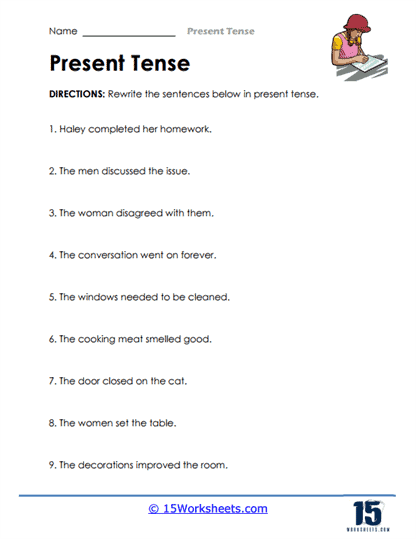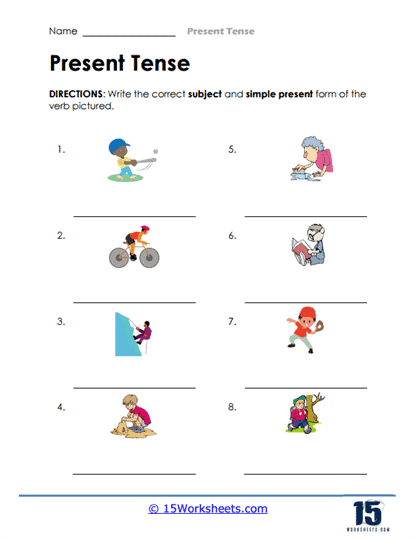Present Tense Worksheets
About These 15 Worksheets
This collection of worksheets are gateways to unlocking a crucial aspect of language mastery. These worksheets, often overlooked, serve as an essential bridge between theory and real-world communication. By focusing on the present tense, learners are given the foundation to express what is happening now, to describe habitual behaviors, to articulate universal truths, and even to predict or plan for the future. These are not just dry grammar exercises; they are the building blocks of dynamic, everyday communication, enabling students to navigate the intricacies of language with precision and ease.
At the heart of every language is the ability to express time. In English, the present tense is particularly versatile, with layers of meaning embedded in its various forms. Whether we are talking about the simple actions of daily life, ongoing events, or even connecting the past to the present, the present tense is indispensable. This is where present tense worksheets come into play, offering learners an opportunity to internalize the rules and structures that govern these forms. Through regular practice, students can move from simply understanding the theoretical aspects of the tense to using it naturally and fluently in conversation and writing.
The objective of present tense worksheets is multifaceted. They do more than just drill grammar rules; they provide clarity on the distinct uses of the four main present tense forms in English: the simple present, present continuous (also known as the present progressive), present perfect, and present perfect continuous. Each of these tenses serves a unique purpose, and without proper instruction, students might struggle to differentiate between them. For example, the simple present is used for habitual actions, such as “She walks to school every day,” while the present continuous captures actions happening right now, like “She is walking to school.” Without these nuances, communication would lose its clarity and depth.
The present perfect tense, on the other hand, ties past actions to the present moment, giving language a sense of continuity. “She has walked to school” implies that the action was completed but has relevance now. The present perfect continuous takes it a step further by emphasizing the ongoing nature of an action that began in the past and continues into the present, such as, “She has been walking to school for an hour.” Each form tells a different story, and these distinctions are critical for effective communication.
But mastering these tenses is not always intuitive, especially for non-native speakers. This is why present tense worksheets are so vital. They provide structured exercises that guide learners through the complexities of these forms. With a blend of fill-in-the-blank activities, sentence transformation tasks, and creative writing prompts, the worksheets cater to various learning styles. Whether a student learns best through repetition, visualization, or hands-on practice, there is an exercise designed to meet their needs.
These worksheets do more than teach grammar-they foster confidence. As students work through examples, correcting mistakes and internalizing patterns, they gain a sense of achievement. This confidence transcends the classroom. A student who understands how to use the present tense effectively will not only excel in academic settings but will also carry these skills into everyday conversations, job interviews, and professional writing. In essence, these worksheets help students find their voice, enabling them to communicate more effectively and persuasively.
Grammar is not an isolated skill; it is deeply intertwined with vocabulary, reading comprehension, and even critical thinking. By mastering tense usage, students sharpen their ability to interpret and analyze texts, understand context, and respond appropriately in conversations. The regular practice that these worksheets offer helps reinforce neural pathways, turning what might initially seem like a mechanical exercise into intuitive language use.
These worksheets offer students a glimpse into how language functions in different contexts. For example, the present continuous tense is often used in storytelling to create a sense of immediacy, while the simple present tense can describe facts or universal truths. Understanding these subtle differences enriches a student’s ability to appreciate literature, engage in meaningful dialogue, and even create more compelling narratives of their own.
Types of Exercises
Fill-in-the-Blank Exercises – These are standard exercises where students fill in blanks with the correct form of a verb in the present tense. This type of exercise is great for practicing conjugation and verb forms.
Sentence Transformation Exercises – These exercises require students to rewrite sentences in different present tense forms, helping them understand the nuances between each form.
Matching Exercises – Students match sentence halves or phrases that logically go together, which can include matching subjects with the correct verb forms.
Multiple Choice Questions – These questions test students’ ability to choose the correct present tense form in a given context, enhancing their decision-making skills in grammar usage.
Error Correction Exercises – Students are given sentences with errors in tense usage and are asked to identify and correct them, which helps in developing editing skills.
Dialogue Completion – These exercises involve completing dialogues with appropriate present tense forms, aiding in understanding the practical application of tenses in conversation. Here, students are given a story context and are required to complete it using appropriate present tense forms, encouraging narrative skills and understanding of tense usage in storytelling.
Verb Conjugation Tables – These tables are often included for reference and practice, where students fill in the correct forms of a given verb in different persons (e.g., I, you, he/she/it) and numbers (singular, plural).
Listening and Speaking Activities – Some worksheets include listening exercises where students listen to a text and identify present tense forms or speak using the present tense in response to prompts.
Picture Description Exercises – Students describe a picture using the present tense, which is useful for practicing tense usage in descriptive language.
The Benefits of These Worksheets
Grammar Proficiency – Regular practice with these worksheets enhances a student’s grasp of present tense forms and their correct usage in various contexts.
Improved Writing Skills – Understanding tense agreement and consistency is crucial in writing. These exercises help in developing coherent and grammatically accurate writing skills. Mastery of the present tense is essential for everyday communication. These worksheets prepare students for real-life conversations and interactions.
Cognitive Development – Learning and practicing grammar rules stimulate cognitive functions like memory, problem-solving, and critical thinking.
Confidence in Language Use – As students become more proficient in using the present tense correctly, their confidence in speaking and writing in the language increases. Often, present tense worksheets include exercises that introduce new vocabulary, helping students expand their language repertoire.
Contextual Understanding – Through varied exercises, students learn how to use the present tense in different contexts, enhancing their overall comprehension of the language. Correcting errors and transforming sentences require attention to detail, a skill that is valuable in all aspects of language learning and beyond.
Flexibility in Language – By practicing different present tense forms, students learn to adjust their language use according to the situation, audience, and purpose. Worksheets often provide an opportunity for self-assessment and feedback from teachers, which is crucial for language development.
What is the Present Tense?
The present tense is a grammatical tense used to describe actions that are happening right now or general truths that are always valid. In English, it’s one of the most commonly used tenses and serves multiple purposes in communication. There are various forms of the present tense, each with specific rules for conveying different types of actions or states.
First, the simple present tense expresses habits, repeated actions, or universal truths. It is formed by using the base form of the verb, except for the third-person singular where an “s” is added (e.g., “She runs every morning”). This tense is also used to state facts, such as “The Earth revolves around the Sun.” In these cases, the present tense isn’t about an action occurring at this very moment but something that happens regularly or is always true.
The present continuous tense, also called the present progressive, describes actions that are ongoing at the moment of speaking. It is formed by combining the verb “to be” with the present participle (the verb form ending in “-ing”). For example, “I am writing a letter” means the action is currently in progress. This form is useful when you want to emphasize that something is happening right now or around the present moment.
Bringing These Concepts to Life in Examples
Simple present – “Every Saturday, Sarah bakes cookies with her kids.” This sentence highlights a habit. Sarah doesn’t bake cookies only this Saturday; it’s something she does regularly, which is what the simple present expresses.
Present continuous – “I am learning how to play the guitar.” In this case, the speaker emphasizes that the action of learning is happening at this moment or during this period.
The present tense can be used to communicate not only immediate actions but also habitual behaviors and ongoing events, making it a versatile tool in everyday language.















